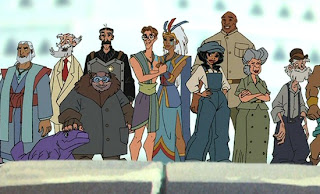It seems every time historical fiction attempts to show a different era of the past with the occasional minority here or there, a segment of the population labels this as just inappropriately or inaccurately reflecting our modern society, instead of those of the past.
I would love to see a Civil War film that features Mexican and Tejano fighters on both sides particularly in the Western theater, but if a historically accurate movie like that ever came out, it would be denounced as "PC grandstanding" by many historically ignorant critics unaware of the lengthy presence of Latinos in the United States (it seems like many just started noticing Latinos existed here in the 'states in something like 2007 despite being one of the most historically established national groups).
This is my general point: the presence of minorities in historical films is not historical inaccuracy. It was their absence in movies of the past that was inaccurate. Today's movies, for the most part, are getting it right and it's movies in the past that whitewashed and ignored minorities, like old Westerns, which were the less historically correct depictions. Black cowboys and cowpunchers were normal in many places and it was Hollywood that overlooked them for generations.
Recently "The Shakespeare Code" was a Doctor Who episode set in London in the 1590s which featured black extras. Predictably enough, this prompted an outcry. However many black slaves and descendants of slaves were living in London in that era, to the point where Queen Victoria wrote a letter to the mayor of London in 1596 where she expelled slave descended blacks from England, with "there are of late divers blackmoores brought into this realme, of which kinde of people there are allready here to manie."
This criticism is a little weirder when applied to adventure and science fiction movies. Captain America's handpicked Howling Commandos struck a lot of people as unrealistic because it had a black guy in the era of the segregated armed forces, and a Japanese-American. In the words of Mike Stoklasa, "shouldn't he be in an internment camp?"
I'm sure the notion a Japanese-American couldn't be a vet in the European theater must come as something of a surprise to the 442nd Regimental Combat Team, aka the Buddhaheads, with their gutsy patois motto, "Go For Broke!" You know, the 442nd Combat Regiment, the most highly decorated regiment in the entire history of the armed forces, including 21 Congressional Medals of Honor?
In the circumstances of the movie, the black guy (Gabe Jones) was a prisoner at a POW labor camp. As the Howling Commandos are an eccentric, unconventional team made of people Captain America trusts as opposed to a traditional armed forces unit, not only is this criticism unbelievably petty, but totally unfounded in the internal logic of the movie.
(Also, it's worth pointing out Peggy Carter, Cap's tough girlfriend, was not a Howling Commando and was a more historically accurate intelligence and scientific officer in a noncombat position.)
The expedition in Atlantis: the Lost Empire were specialists collected together by an eccentric, weirdo millionaire who was crackpot enough to look for Atlantis. Is it really that unbelievable the group he selected would break a few social conventions? After all, Teddy Roosevelt's Rough Riders, another group formed together by an awesome, eccentric rich weirdo, featured black boxers and other crazy characters.
Bear in mind I am not saying there are no such things as slip-ups, because sometimes historical fiction, without meaning to, can reflect our own society instead of those of the past. For instance, a friend of mine remembers a few detective stories written in the past few years features a female police officer in the 1920s. Women cops are such a part of our world it seems unbelievable there was a time when there weren't any.
Why do so many people instinctively rebel against portrayals of minorities in historical fiction even when that portrayal has a grounded historical basis? The easy answer is a kind of subtle bigotry, but I don't think that's it at all. Rather, it can be found in the way the history of minority groups is taught, as a story about the fight against poverty and oppression, instead of as a story of achievement.
















